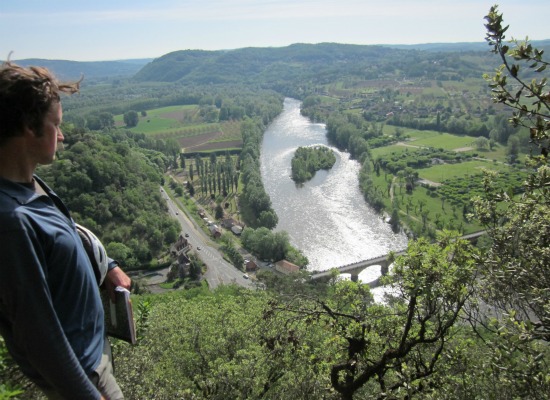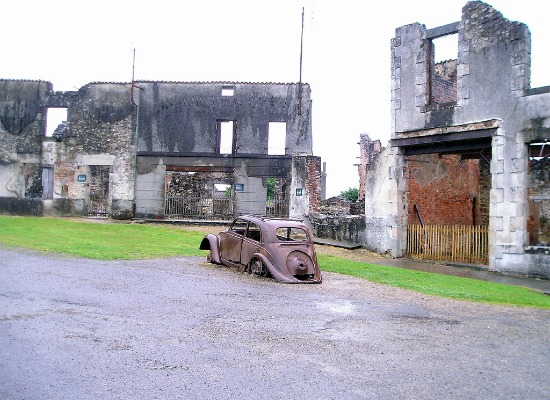Resistance to Nazis in a Land Riddled with Caves
We wondered if the cave’s tenants peered down at the valley and if they wrapped all glassware in cloth to prevent reflective giveaways to the Nazis below
/https://tf-cmsv2-smithsonianmag-media.s3.amazonaws.com/filer/20120522013028CaveHilltopSMALL.jpg)
We rode out of St. Julien, across the bridge over the Dordogne River and a mile down the other side of the river. We turned right on a side road toward a settlement called Le Gard and pedaled uphill along the narrow country road until we saw on our right about one acre of grapevines. We pulled over and locked our bikes to a tree, and along the south edge of the vineyard we went, following a path that quickly led us into the chestnut forest. We climbed uphill, the trail taking us through a second-growth plantation marked with the signs of an active logging industry—clearings, piles of logs and stumped trees ringed by spindly shoots, all fighting toward the sunlight splashing through the canopy. In the mud and leaf litter, among the acorns and chestnuts, were scars of rooting wild pigs.
The trail took us upward and eventually wound to the right, spiraling uphill and toward the summit of what was revealing itself to be a conical hill. The dense woods prevented us from seeing outward until we were near the top, and–just as our landlord had described to us when giving us directions–we came to a slight but dramatic opening in the trees. Stepping to the edge of an outcropping, we saw for miles before us the valley of the Dordogne. The river snaked eastward several hundred feet below, and the Rouffillac Chateau sat on its hillside perch almost straight across the void, over the highway to Carlux. Looking to our village, we could see the church tower and, after a bit of speculating, we identified our own house.
But we hadn’t come here to look outward from this mountain; we had come to look inside it. After taking a few photographs, we followed the trail the final yards, pushed a few branches out of our way, and scrambled down a rocky drop—and there it was, the cave we had come looking for, the grotto in which locals had hidden during World War II whenever Nazi activity became particularly hot and nasty. The opening could not be seen from below, for it was buried by the oak canopy. The entrance was some 10 feet high, and as we stepped into the gaping maw, the temperature dropped from 80 Fahrenheit to a damp 65 or so within. We looked at the raised earth terrace where, so we had been told, the cave’s tenants had laid down ferns as bedding. We wondered if they cooked inside or out, if they peered often through the bushes down at the valley, if they wrapped all glassware and metal in cloth to prevent reflective giveaways to the Nazi soldiers below and if, perhaps, they occasionally even enjoyed themselves with wine and food while they waited for some of the most evil people ever to inhabit the Earth to go away.

From the nameless hilltop cave site, one can look down upon the Dordogne River, the village of St. Julien de Lampon and---directly below, along the highway---Rouffillac, where, on June 8, 1944, Nazi soldiers locked 16 people into a bakery and burned them alive. Photo by Roger Bland.
The Nazis did, of course, eventually leave. They went north after D-Day to fight the Allied Forces on the Normandy coast—but as they went, the German soldiers committed atrocities that locals remember for seven decades and counting. On June 8, 1944, Major Adolf Diekmann, at the time summering in the Périgord with his Nazi battalion, stopped just beneath the cave in the hamlet called Rouffilac. He demanded that the proprietress make him and his men some crepes. She refused—so Diekmann burned her and 15 others to death in the bakery. The same group of soldiers killed 99 people the next day in Tulle, and the day after that burned alive 642 more in Oradour-sur-Glane, including 205 children. Diekmann was killed in battle before he could be tried for war crimes.
Fleeing such horrors, people of the area, including fighters of the Resistance, came to this hole in the mountain.
In local caves, the layers of wartime history lie deep. I spoke to a man in our village named Jean Lauvinerie. Now 86, he was a teenager during the Nazi occupation, and though he doesn’t know of the cave above Rouffillac, he told me as we talked in his kitchen that many other holes in the bedrock around St. Julien served as weapons caches and hideouts for the Resistance fighters during World War II. Mr. Lauvinerie was too young at the time to fight, but he did work as a courier, delivering messages to the men and women in hiding in the hills. Lauvinerie was eventually recognized by the government for his help during the war and some years after the Germans were defeated, Lauvinerie accepted an honorary arm band which he still keeps in a box in the cupboard, in his and his wife’s small home beside the butcher, across from the church—but he declined a handful of medals.
“So many others did so much more than me in the war,” he said. “Compared to them, I didn’t deserve medals.”

To this day, the streets and buildings of Oradour-sur-Glane remain in rubble. Nazi soldiers killed 642 people here on June 10, 1944, two days after rampaging past St. Julien de Lampon. Photo courtesy of Flickr user Verity Cridland.
Planning Your Next Trip?
Explore great travel deals
Smithsonian magazine participates in affiliate link advertising programs. If you purchase an item through these links, we receive a commission.
/https://tf-cmsv2-smithsonianmag-media.s3.amazonaws.com/accounts/headshot/Off-Road-alastair-bland-240.jpg)
/https://tf-cmsv2-smithsonianmag-media.s3.amazonaws.com/accounts/headshot/Off-Road-alastair-bland-240.jpg)